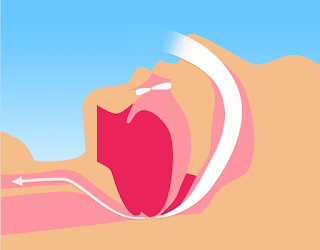OBSTRUCTIVE SLEEP APNEA
Obstructive sleep apnea (OSA) syndrome is an often overlooked cause of airway obstruction in the PACU, given that most patients are actually not obese and the vast majority of patients are undiagnosed at the time of surgery.
It is well known that patients with OSA are at an increased risk of suffering from cardiopulmonary complications as compared to the general population not affected by OSA syndrome. Patients with OSA are particularly prone to airway obstruction and should not be extubated until they are fully awake and following commands. Any redundant compliant pharyngeal tissue in these patients not only increases the incidence of airway obstruction, but can also increase the difficulty of intubation by direct laryngoscopy. Once in the PACU, a patient with OSA whose trachea has been extubated is exquisitely sensitive to opioids and, when possible, continuous regional anesthesia techniques should be used to provide postoperative analgesia. Other opioid-sparing techniques should be utilized, such as scheduled acetaminophen, and use of nonsteroidal antiinflammatory drugs (NSAIDs) when not contraindicated. One may also employ the use of ketamine, dexmedetomidine, and clonidine, all of which can also decrease postoperative opioid requirements. Interestingly, benzodiazepines can have a greater effect on pharyngeal muscle tone than opioids, and the use of benzodiazepines in the perioperative setting can significantly contribute to airway obstruction in the PACU.
Another strategy to employ when caring for a patient with OSA is to position them in either an upright (seated, reverse Trendelenburg) or semi-upright position whenever possible, as the supine position is known to worsen OSA.
In addition, the use of goal-directed fluid strategies should be utilized with consideration of lower salt-containing substances, as these patients are more prone to fluid shifts, which can worsen airway edema.
When caring for a patient with OSA, plans should be made preoperatively to provide CPAP in the immediate postoperative period. Patients should be asked to bring their own CPAP machines with them on the day of surgery to enable the equipment to be set up before the patient’s arrival in the PACU (post-anesthesia care unit). Patients who do not routinely use CPAP at home or who do not have their machines with them may require additional attention from the respiratory therapist to ensure proper fit of the CPAP delivery device (mask or nasal airways) and to determine the amount of positive pressure needed to prevent upper airway obstruction.
In patients with OSA who are morbidly obese, immediately applying CPAP postextubation in the operating room rather than waiting to apply positive pressure in the PACU may offer additional benefits. In patients undergoing laparoscopic bariatric surgery, Neligan and colleagues compared the application of 10 cm H2O CPAP immediately postextubation to instituting the same CPAP 30 minutes later in the PACU. When compared with matched controls, patients who received immediate CPAP demonstrated improved spirometric lung function (i.e., functional residual capacity [FRC], peak expiratory flow [PEF], and forced expiratory volume [FEV]) at 1 hour and 24 hours postoperatively.
Two large cohort studies demonstrated that patients with OSA who are not treated with positive airway pressure (PAP) preoperatively are at increased risk for cardiopulmonary complications after general and vascular surgery and that PAP therapy was associated with a reduction in postoperative cardiovascular complications. If the patient can tolerate PAP, and their surgical procedure is not a contraindication to its application, patients with OSA should use a PAP device postoperatively.



